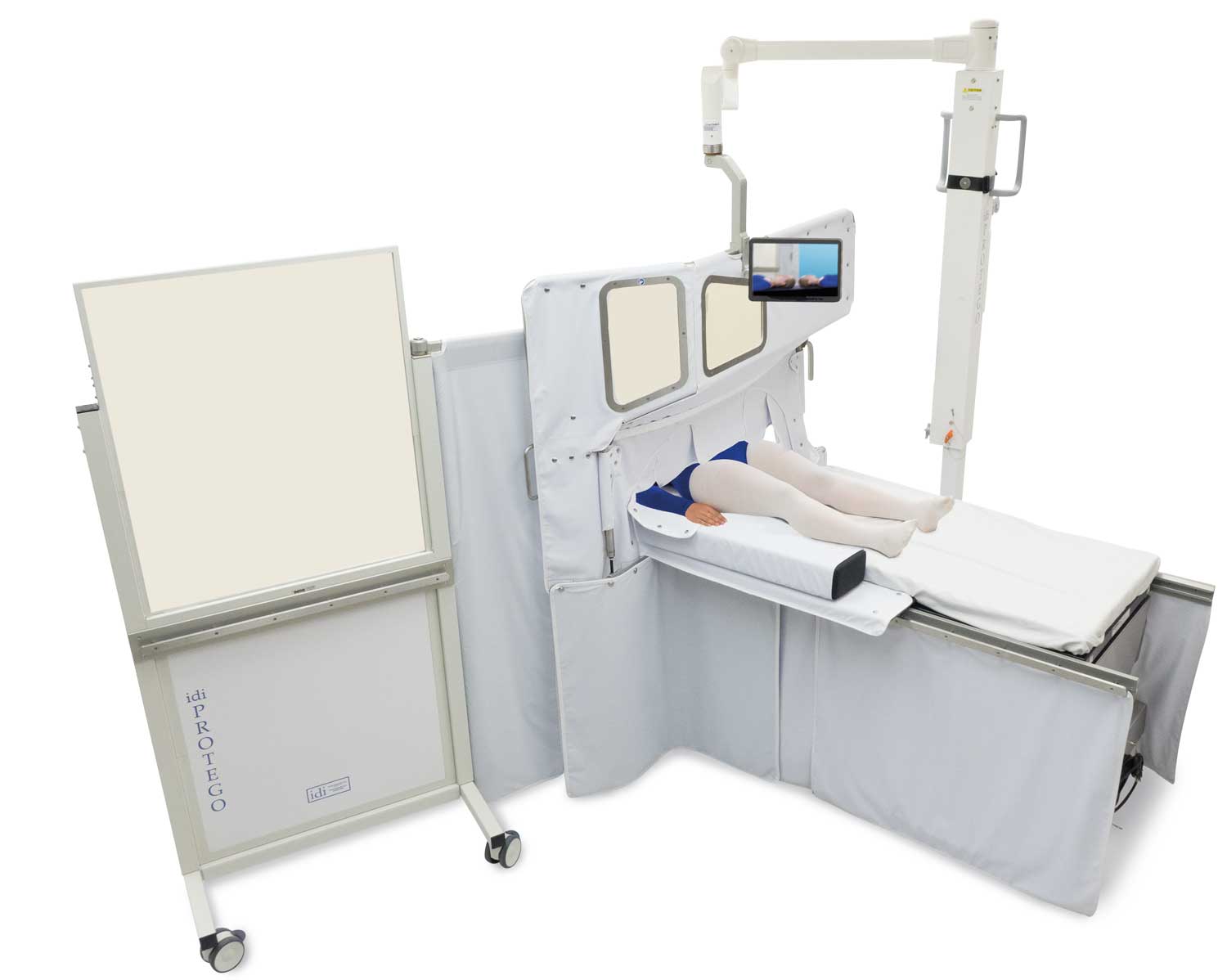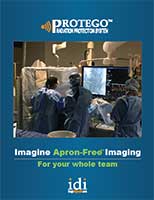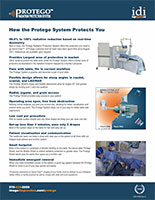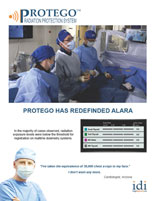
Protego is a compact radiation barrier system for use in cardiac cath labs.
The Protego system was designed to eliminate the requirement of heavy protective aprons typically worn by Physicians,
Fellows and Staff during interventional procedures while greatly extending protection to exposed areas
normally not protected by shielding material.
*Procedure parameters for Apron-Free™ imaging at your facility must be defined by your Radiation Safety Officer or facility physicist as well as comply with state and local regulations.
PROTEGO HAS REDEFINED ALARA!
In the tweets below the exposure was below the sensitivity threshold of the dosimetry devices
EVIDENCE BASED*
![]()
Michigan Occupational Safety and Health Administration February 2021
“The shielding device should be accepted in lieu of the requirement for lead aprons. This device is equivalent to at least 0.5 mm lead and protects individuals equivalent to or better than lead aprons.”
Published clinical data showed 95.9% to 99.8% reduction in radiation exposure.
EASY ADOPTION
![]()
- Superior radiation protection for the whole interventional team
- An optional platform for apron-free procedures
- Connects to and pans with the table
- Passive offset design allows for steep caudal, cranial, RAO and LAO angulations
- Suitable for structural and PCI interventions
- Nominal Footprint
- 3 min set up
- Supports radial, groin and jugular access
- Low procedure cost
QUALITY OF LIFE
![]()
Studies show the negative long-term results of wearing heavy, yet insufficient, lead aprons on surgical staff, including brain tumors, cataracts, spinal disk injury, and other life-impacting problems. All of this ads up to reduced quality of life, missed work, and shorter careers.
The Protego™ Radiation Protection System can free staff from both radiation and the consequences of using lead aprons and other radiation protection devices, helping to improve long-term health, job satisfaction, and career longevity.
I have been exposed to the equivalent of 30,000 chest x-rays.
“I don’t want any more
Cardiologist, Arizona
Clinicians talk about using Protego in the Cath Lab
In the videos below the exposure was below the sensitivity threshold of the dosimetry devices

DRAMATICALLY REDUCE THE NEED TO WEAR APRONS
Protects all team table-side members
“Based on the findings of the present study, the open architecture of the shielding system casts an umbrella of protection on the operator side of the table. Hence, the shielding system offers protection not only to “table side” physicians and technologists, but also to the other circulating catheterization laboratory staff during the times in which they are within the “umbrella” of protection. By offering protection from scatter radiation to the entire catheterization laboratory team, the shielding system may have benefits beyond radiation safety devices designed only to protect the physician.”
From Dixon, et al, “A novel catheterization laboratory radiation shielding system: Results of pre-clinical testing,” Cardiovascular Revascularization

REDUCE BACK AND NECK PAIN
Wearing a 15-pound lead apron can place pressures of up to 300 pounds per square inch on intra-vertebral disks. According to the Society of Interventional Radiology, 70 percent of Interventional Cardiologists experience lower back pain, 40 percent experience neck pain and 42 percent experience both. They recommend the use of shielding systems, like our Protego™ Radiation Protection System, that reduce or eliminate the need for protective garments.
PROTEGO MAIN COMPONENTS
COMPLETE PROTEGO SYSTEM COMPONENTS
Drape for Radial Arm Shield Pad (1 each)
PROTEGO FAQS
HOW DID THE PROTEGO SYSTEM COME TO BE DEVELOPED?
The creation and subsequent evolution of the Protego design began nearly 20 years ago as an effort by a leading Michigan cardiologist to reduce and eventually eliminate physician and staff exposure to x-ray scatter during procedures.
The initial concept resulted in a design that was essentially a tall leaded vinyl wall separating the patient from the cardiologist. Not only was it intimidating to the patient, but it also limited the C-Arm angulation required for common views and was challenging to drape. From a proof-of-concept standpoint, it did provide protection for the entire team.
After many more iterations over the years and a great deal of design work and testing, the current Protego design came to life. Today’s Protego design resolves the early deployment and operative issues with a smaller and easy-to-deploy shield, allowing for extreme angulation while maintaining the doctor-patient connection.
IS PROTEGO AVAILABLE FOR MY CATH LAB SYSTEM?
Protego is currently available for Philips and Siemens Cath lab systems. Call (978) 829-0009 with questions or request a quote online.
HOW MUCH RADIATION SHIELDING PROTECTION CAN I EXPECT FROM PROTEGO?
RESULTS OF PRE-CLINICAL TESTING
“Use of the shielding system was associated with greater than 94.2% reduction in scatter radiation across all reference points in the PA and LAO projections with fluoroscopy and cine. With the shielding system, dose reductions at the location of the primary operator ranged from 97.8% to 99.8%. At locations of maximum scatter radiation, use of the shielding system resulted in dose reductions ranging from 97.8% to 99.8% with fluoroscopy and from 97.9% to 99.8% with cine.”
ABSTRACT: “A novel catheterization laboratory radiation shielding system: Results of pre-clinical testing”
DO I NEED TO WEAR A LEAD APRON OR OTHER PERSONAL PROTECTIVE FEAR DURING A CASE WITH PROTEGO?
Image Diagnostics has Protego installations where team members are Apron-free. We suggest that until all member of the Team are well versed and proficient in the draping process and installation and that Team members wear some form of real time (Ray Safe) dosimetry (thyroid and waist) to confirm that the system has been draped properly.
The Protego Shielding system is built upon overlapping layers of scatter absorbent materials which must all be in place at all times to prevent shielding leakage. The Protego Shielding system provides comprehensive superior radiation protection when deployed, draped and configured as defined within our manual and demonstrated throughout our in-service and training process. This high level protection has been demonstrated through testing by independent radiation physicists and supported within the approval from the Michigan Occupational Safety and Health Administration.
The protection afforded by Protego is predicated on correct positioning and use. In order to ensure comprehensive Team protection at all times, it is critical that the draping and shield deployment process be followed.
Elimination of personal protection devices and apparel during the use of Protego is at the discretion and approval of the hospital Radiation physicist and subject to each hospital’s radiation safety policy and protocols.
WHAT KIND OF DOSE REDUCTION SHOULD I EXPECT FROM USING THE PROTEGO?
IDI is constantly monitoring Protego’s clinical performance Recent testing shows reductions of 97.8% to 99.8% while using cine or fluoroscopy modes. The range of coverage of the system is approximately one half of the room providing coverage for all the Team and clinical staff.
The State of Michigan testing indicates that the Protego system “should be accepted in lieu of the requirements for lead aprons” and is “at least .5 mm lead equivalence.
“The level of protection provided by Protego has been demonstrated to equal or exceed 0.5 mm of lead apparel. Unlike conventional lead aprons, the entire body is afforded this protection. The State of Michigan has now certified that this shielding system provides a level of protection such that operators using it do not need to wear personal leaded protective apparel”
MICHIGAN OCCUPATIONAL SAFETY AND HEALTH ADMINISTRATION – MIOSHA RSS-0037
Dixon Pre-clinical Testing
State of Michigan
CAN I PAN THE TABLE WITH THE PROTEGO ATTACHED?
Yes, the cross shield is mounted onto a spring arm that keeps it floating above the table. The shield is is lightly connected to the table via flexible magnetic mounting joints allowing for the shield to follow the table when panning.
CAN RADIAL ACCESS PROCEDURES BE PERFORMED USING PROTEGO?
Yes – both radial and femoral access are possible.
HOW DOES THE PROTEGO IMPACT MY CURRENT WORKFLOW?
There is a nominal impact on workflow. 90% of the Protego’s components are pre-installed the night before a case or installed just prior to the the start of a case. After the a patient is loaded on the table:
ARE PROTEGO DEMONSTRATIONS AVAILABLE?
Yes! IDI provides onsite clinical support to install the Protego system at your site as well as education and training around the draping process and product use during the demo. In addition IDI will supply Ray Safe real time dosimetry badges 2 weeks prior to the start of the demo process to allow for before and after Protego dose collection readings. Values pre and post-Protego have ranged up to 8 times more without the Protego system. We also offer virtual demonstrations. To request a demonstration email us at info@getprotego.com or call +1 (978) 829-0009.
“I wish I had Protego in our suite 10 years ago”
Interventional Radiologist
Houston, Texas
STUDY SOURCES:
Information on the Rampart System
Abstract: Assessment of occupational dose reduction with the use of a floor mounted mobile lead radiation protection shield
Authors: Hannah Scott, Sean Gallagher, William Abbott, and Matthew Talboy
Citation: ,,
Link: https://doi.org/10.1016/j.carrev.2021.05.017
Policy Reference: MIOSHA RSS-0037, Card Cath Protection System
Policy Name: “Cardiac Catheterization Operator Protection System in Lieu of Lead Aprons”
Author: Michigan Occupation Safety and Health Administration, Technical Services Division, Policies And Procedures, Radiation Safety Section
Date: February 7, 2021
Article: A novel catheterization laboratory radiation shielding system: Results of pre-clinical testing
Authors: Dixon, Simon R., and Maher Rabah, Scott Emerson, Cheryl Schultz, Ryan D. Madder
Link: https://doi.org/10.1016/j.carrev.2021.05.017
Citation: Dixon, Simon R., et al, “A novel catheterization laboratory radiation shielding system: Results of pre-clinical testing,” Cardiovascular Revascularization Medicine, https://www.sciencedirect.com/science/article/abs/pii/S1553838921002633 May 21, 2021.
Article: Economic Impacts of Radiation Exposures Associated with Interventional Fluoroscopy
Authors: Organization for Occupational Radiation Safety in Interventional Fluoroscopy (ORSIF)
Link: https://orsif.org
Citation: ORSIF, “Economic Impacts of Radiation Exposures Associated with Interventional Fluoroscopy,” https://orsif.org, December 2018.
Poster: “Reduce Radiation Exposure: You Can Have an Impact”
Authors: Organization for Occupational Radiation Safety in Interventional Fluoroscopy
Link: https://orsif.org
Citation: ORSIF, “Reduce Radiation Exposure: You Can Have an Impact,” https://orsif.org, 2015.
Article: Tumors, Bad Backs, and Cataracts: Interventional Physicians Face a Lifetime of Risk
Authors: Michael O’Riordan
Link: https://www.tctmd.com/news/tumors-bad-backs-and-cataracts-interventional-physicians-face-lifetime-risk
Citation: O’Riordan, Michael, “Tumors, Bad Backs, and Cataracts: Interventional Physicians Face a Lifetime of Risk,” Presentations at: International Symposium on Endovascular Therapy; February 6-10, 2016; Hollywood, FL.
Call 978-829-0009 to talk to a product expert





